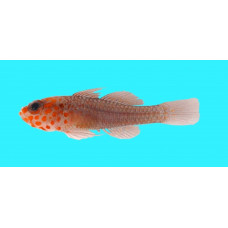Latin name
Trimma fangi
Other name
Trimma fangi
Identification
Fang's pygmygoby is distinguished by a combination of the following characters: absence of predorsal scales; anterior extension of body scales to humeral point; additionally characterised by presence of longitudinal scales of 23-25th row; genae and supraorbital region without scales.
Features of fish fins
Dorsal spines (total): 6 - 7; Dorsal soft rays (total): 9; Anal spines: 1; Anal soft rays: 8.
Fish colouring
These fish have a light brown body with large orange spots or stripes on the head, a dark greyish orange shoulder patch above the base of the pectoral fin, and a grey iris with several orange spots. The orange spots on the head change to red on the gill and foot bands.
Distribution
Widespread in the western Pacific: Anambas Islands, South China Sea.
Habitat
A marine tropical species associated with reefs. Depth range from 5 to 20 metres.
Size
The maximum length of this species is 2.1 cm.
Behavior
Occupies caves and crevices on the outer reef.
Food and feeding habits
This species feeds on small invertebrates, plankton and algae. The fish use their small mouths to pick up tiny prey from the surface of corals and substrate.
Reproduction
Females lay small batches of eggs in hidden crevices. Males usually guard the eggs until they hatch, providing protection from predators and increasing the survival rate of the offspring.
Fishing
Fang's pygmygoby are of no commercial interest to fisheries.
Relationship with a person
Harmless.
| Classification | |
| Phylum | Chordata |
| Class | Actinopterygii |
| Squad | Perciformes |
| Family | Gobiidae |
| Genus | Trimma |
| Species | T. fungi |
| Features | |
| Conservation status | Least Concern |
| Habitat | Pelagic |
| Life span, years | No information |
| Maximum body weight, kg | No information |
| Maximum length, cm | 2,1 |
| Sailing speed, m/s | No information |
| Threat to people | Not edible |
| Way of eating | Planktonophage |
Fang's pygmygoby
Tags: fang's pygmygoby

